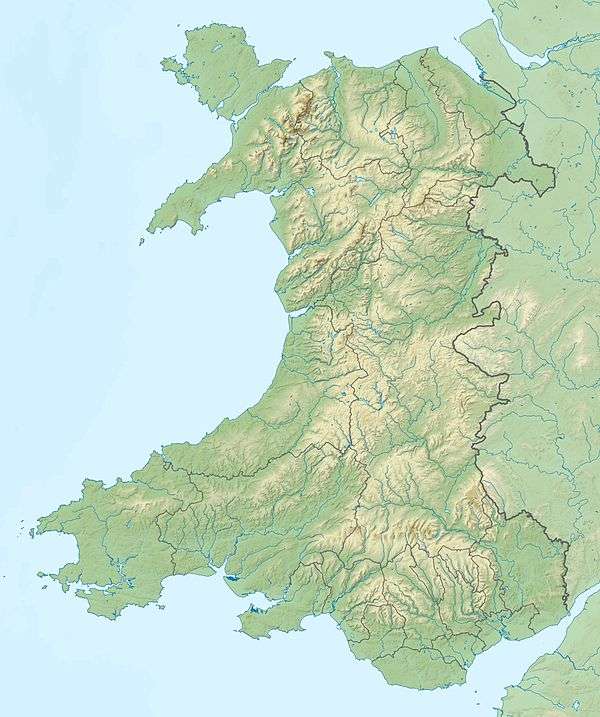Trawsfynydd nuclear power station
| Trawsfynydd nuclear power station | |
|---|---|
 | |
 Location of Trawsfynydd nuclear power station in Wales | |
| Country | Wales, United Kingdom |
| Location | Trawsfynydd, Gwynedd |
| Coordinates | 52°55′29.51″N 3°56′54.38″W / 52.9248639°N 3.9484389°WCoordinates: 52°55′29.51″N 3°56′54.38″W / 52.9248639°N 3.9484389°W |
| Status | Closed |
| Construction began | 1959 |
| Commission date | 1965 |
| Decommission date | 1991 |
| Construction cost | £103 million |
| Owner(s) | Nuclear Decommissioning Authority |
| Operator(s) | Magnox Ltd |
| Nuclear power station | |
| Reactor type | Magnox |
| Reactor supplier | Atomic Power Constructions |
| Power generation | |
| Units decommissioned | 2 x 235 MW |
Trawsfynydd nuclear power station is a disused Magnox power station situated on the north shore of Llyn Trawsfynydd in Gwynedd, Wales. It is significant for being the only Nuclear power station in the UK which was not built on the coast; the plant drew water instead from the nearby lake.
History
The power station was designed by Basil Spence. The construction, which was undertaken by a consortium involving Crompton Parkinson, International Combustion, Fairey Engineering and Richardsons Westgarth, and known as the Atomic Power Constructions (APC),[1] began in July 1959, and both of the reactors were in operation by March 1965, with the station opening fully in October 1968, at a cost of £103 million.[2] It had two Magnox reactors producing 470 megawatts (MW) in total.[2] The reactors were supplied by APC and the turbines by Richardsons Westgarth.[2] The civil engineering work was undertaken by Holland, Hannen & Cubitts[3] and Trollope & Colls.[4] The architectural consultant for the buildings was Sir Basil Spence and the landscape architect was Sylvia Crowe.[5]
Both have been shut down since 1991; the site is in the process of being decommissioned by the Nuclear Decommissioning Authority.[6]
Transporting nuclear materials
The Bala to Blaenau Ffestiniog railway line had closed completely in January 1961, but its tracks and infrastructure had been mothballed against the possibility of freight or military traffic resuming. The line had a siding approximately half a mile west of the power station. In 1963-4 a "Goliath" gantry crane was installed over the siding.[7][8][9][10] A single track was restored northwards and a wholly new connection was laid in the centre of Blaenau Ffestiniog between the restored line and the extant Conwy Valley Line. This allowed nuclear flasks to be sent and received by rail to destinations such as Sellafield.
The line and siding opened on 20 April 1964 and served the power station until the last regular train of flasks was dispatched on 8 August 1995.[11] One further final train of nuclear material headed north from the loading point on 22 April 1997, hauled by EWS Loco 37426.[12] The line was subsequently mothballed once more.[13]
See also
- Energy policy of the United Kingdom
- Nuclear power in the United Kingdom
- Energy use and conservation in the United Kingdom
References
- ↑ The UK Magnox and AGR Power Station Projects
- 1 2 3 Nuclear Power Plants in the UK - Scotland and Wales
- ↑ An historical survey of Cubitts, from the Company's inception in 1810 to the present day Page 25, Cubitts, 1975
- ↑ Trollope & Colls at the National Archives
- ↑ Site record for Trawsfynydd on RCAHMS index for Sir Basil Spence archive
- ↑ "How do you close a nuclear power station?". BBC. 28 October 2013. Retrieved 29 July 2016.
- ↑ The siding and Goliath, via 2D53
- ↑ Mitchell & Smith 2010, Photo 28.
- ↑ Southern 1995, p. 71.
- ↑ A flask being loaded onto a railway wagon, via flickr
- ↑ Three flasks passing Blaenau on 8 August 1995, via flickr
- ↑ Mitchell & Smith 2010, Photo 66.
- ↑ "Inquiry into radioactivity scare". The Independent. 22 April 1997. Retrieved 9 August 2016.
Sources
- Mitchell, Vic; Smith, Keith (2010). Bala to Llandudno: Featuring Blaenau Ffestiniog. Midhurst, West Sussex: Middleton Press (MD). ISBN 978 1 906008 87 1.
- Southern, D. W. (1995). Bala Junction to Blaenau Ffestiniog (Scenes from the Past, Railways of North Wales, No. 25). Stockport: Foxline Publishing. ISBN 1 8701 19 34 7.
External links
- Nuclear Decommissioning Authority site (Trawsfynydd page)
- Trawsfynydd , Nuclear Engineering International wall chart, January 1961
- Some photos of Trawsfynydd power station
- Aerial views of the power station, via The People's Collection